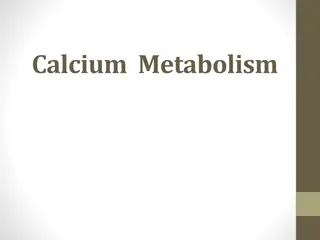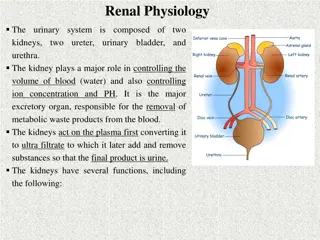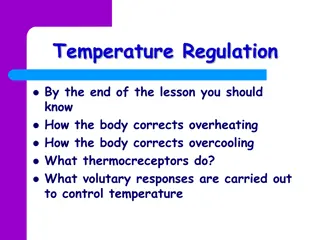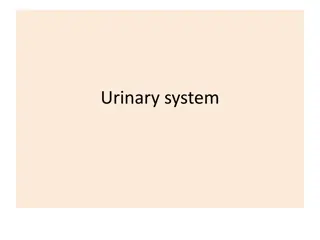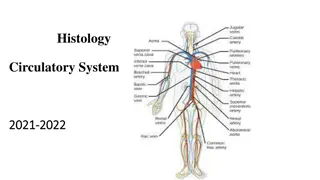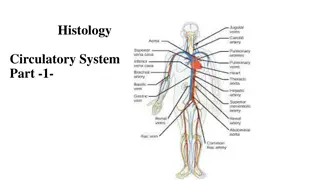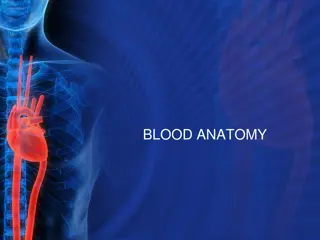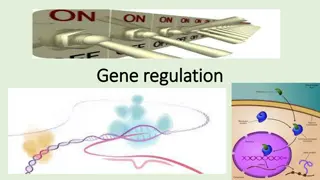Understanding Homeostasis in Humans: The Key to Maintaining Internal Balance
Homeostasis refers to the body's ability to regulate and maintain a constant internal environment despite external changes. In humans, the tissue fluid plays a crucial role in this process, with factors like pH, water concentration, oxygen levels, temperature, and glucose content needing to be controlled for optimal cellular function. The internal environment of humans depends on the composition of tissue fluid, which must be kept constant to support cell health and overall well-being.
Download Presentation

Please find below an Image/Link to download the presentation.
The content on the website is provided AS IS for your information and personal use only. It may not be sold, licensed, or shared on other websites without obtaining consent from the author. Download presentation by click this link. If you encounter any issues during the download, it is possible that the publisher has removed the file from their server.
E N D
Presentation Transcript
LIFE SCIENCES GRADE 12 CAPS STRUCTURED, CLEAR, PRACTICAL - HELPING TEACHERS UNLOCK THE POWER OF NCS KNOWLEDGE AREA: Life Processes in Plants and Animals TOPIC 3.2: Homeostasis in Humans Homeostasis
SUMMARY OF PRESENTATION: Definition of Homeostasis Internal Environment of Humans and the Conditions on which it Depends. Conditions within the Tissue Fluid that should be kept Constant. Negative Feedback Mechanism to Maintain Homeostasis Thermoregulation
DEFINITION OF HOMEOSTASIS: Homeostasis refers to the ability of the body to maintain a constant internal environment irrespective of changes in the external environment.
TERMINOLOGY: TERM: Homeostasis DEFINITION: USE IN SENTENCE: Refers to the ability of the body to maintain a constant internal environment irrespective of changes in the external environment. Osmoregulation is an example of homeostasis.
INTERNAL ENVIRONMENT OF HUMANS AND THE CONDITIONS ON WHICH IT DEPENDS Tissue fluid is the internal environment of multicellular organisms. Cells are surrounded by the tissue fluid. Tissue fluid is also called interstitial fluid. Diagram showing tissue fluid
INTERNAL ENVIRONMENT OF HUMANS AND THE CONDITIONS ON WHICH IT DEPENDS Tissue fluid is made up of many solutes. These are substances that are dissolved in water. Some of these solutes are salt, sugar, hormones, amino acids etc, The composition of the tissue fluid is affected by may factors. Some of these factors are: pH Water concentration Oxygen and carbon dioxide content Temperature and Glucose content. 1. 2. 3. 4. 5.
INTERNAL ENVIRONMENT OF HUMANS AND THE CONDITIONS ON WHICH IT DEPENDS The composition of the tissue fluid needs to be kept constant in order to maintain the correct functioning of the cells. Therefore the factors mentioned above must be controlled to maintain the constancy of the tissue fluid.
TERMINOLOGY: TERM: Tissue fluid/interstitial fluid DEFINITION: USE IN SENTENCE: Refers to the fluid that bathes or surrounds the cells of multicellular organisms. The composition of the tissue fluid must be kept constant to prevent a negative effect on the functioning of the cells.
CONDITIONS WITHIN THE TISSUE FLUID THAT SHOULD BE KEPT CONSTANT: As mentioned earlier some of the factors that need to be maintained or controlled in order to maintain the constancy of the tissue fluid are Glucose concentration Water content pH Oxygen and carbon dioxide concentration Temperature 1. 2. 3. 4. 5.
INTERNAL ENVIRONMENT OF HUMANS AND THE CONDITIONS ON WHICH IT DEPENDS When we talk about these factors being controlled it is not possible for them to be the same all the time. Therefore we say that they must be kept constant within narrow limits. This means that the changes that occur must be very small or only slight.
NEGATIVE FEEDBACK MECHANISM TO MAINTAIN HOMEOSTASIS: The levels of glucose, gases and water within the blood must be kept constant, within narrow limits. This is done using the negative feedback mechanism. We already know how the negative feedback mechanism works in the endocrine system, but Negative feedback can also be achieved through the nervous system.
NEGATIVE FEEDBACK MECHANISM TO MAINTAIN HOMEOSTASIS: In this case any change or imbalance is sent back to the nervous system. The nervous system then responds by sending impulses to bring about a negative response. In this way the imbalance is corrected .
NEGATIVE FEEDBACK MECHANISM TO MAINTAIN HOMEOSTASIS: Lets look at how each of the above substances in the blood are kept constant within narrow limits. Maintaining the Blood Glucose Levels: 1. Remember that the blood glucose level is maintained using the hormones Insulin and Glucagon a) b) Now lets look at how each hormone does this.
NEGATIVE FEEDBACK MECHANISM TO MAINTAIN HOMEOSTASIS: a) Insulin: When the level of the blood sugar is too high The information is sent to the islet of Langerhans in the pancreas. The islet secretes the hormone insulin. Insulin then reduces the blood glucose level. It reduces the blood sugar levels in the following way It allows the glucose to be absorbed into the cells, it is then used by the cells for cellular respiration. 1.
NEGATIVE FEEDBACK MECHANISM TO MAINTAIN HOMEOSTASIS: It causes the cells of the liver and muscles to convert the excess glucose into glycogen and store it. Therefore the levels of glucose is lowered to normal. 2. Therefore this is an example of a negative feedback because The high levels of glucose is referred to the pancreas, which in turn secretes insulin which then lowers the blood glucose level.
NEGATIVE FEEDBACK MECHANISM TO MAINTAIN HOMEOSTASIS: Glucagon: b) When the blood glucose level is too low The information is sent to the islet of Langerhans in the pancreas. The islet secretes the hormone glucagon. Glucagon then increases the blood glucose level. It increases the levels of glucose in the following way It causes the glycogen in the liver and muscle cells to be converted back into glucose. 1.
NEGATIVE FEEDBACK MECHANISM TO MAINTAIN HOMEOSTASIS: In this way the levels of glucose is increased to normal. Therefore this is an example of a negative feedback because The low levels of glucose is referred to the pancreas, which in turn secretes glucagon which then increases the blood glucose level to normal.
NEGATIVE FEEDBACK MECHANISM TO MAINTAIN HOMEOSTASIS: Maintaining the oxygen and carbon dioxide levels: 2. When physical activity is increased, the body needs more energy. Therefore cellular respiration increases to provide this extra energy. The increased cellular respiration releases more carbon dioxide.
NEGATIVE FEEDBACK MECHANISM TO MAINTAIN HOMEOSTASIS: This means that the levels of carbon dioxide in the body increases. If the levels of carbon dioxide becomes too high it can affect the pH of the tissue fluid. Therefore the levels of carbon dioxide must be kept constant with narrow limits. This is done through the negative feedback mechanism. Lets look at how this is achieved.
NEGATIVE FEEDBACK MECHANISM TO MAINTAIN HOMEOSTASIS: When the levels of carbon dioxide increases, special receptors in the medulla oblongata become stimulated. The medulla oblongata then sends impulses to the heart and breathing muscles (diaphragm and intercostal muscles). This causes the heart to beat faster. Therefore blood rich in carbon dioxide is carried at a faster rate to lungs from the heart. Remember that the breathing muscles are responsible for the breathing movements, which are inhalation and exhalation.
NEGATIVE FEEDBACK MECHANISM TO MAINTAIN HOMEOSTASIS: The breathing muscle now speed up inhalation and exhalation. These movements are also increased when the abdominal muscles pushes up the diaphragm with more force. Carbon dioxide is therefore exhaled faster. This means that the levels of carbon dioxide is lowered to normal.
NEGATIVE FEEDBACK MECHANISM TO MAINTAIN HOMEOSTASIS: This is an example of a negative feed back mechanism because When the levels of carbon dioxide increases, the medulla oblongata responds by increasing the breathing movements and the heart rate and therefore causing carbon dioxide to leave the body at a faster rate. Therefore the levels of carbon dioxide is lowered to normal. In this case the nervous system is responsible for marinating the carbon dioxide levels by using the negative feedback mechanism.
NEGATIVE FEEDBACK MECHANISM TO MAINTAIN HOMEOSTASIS: Osmoregulation: 3. Remember that osmoregulation refers to maintaining a water balance. In the human body osmoregulation is brought about using the nephron of the kidney. You studied this last year. Lets see if you remember
NEGATIVE FEEDBACK MECHANISM TO MAINTAIN HOMEOSTASIS: When the level of water in the body is too high then Then special receptors called osmorecepters become stimulated. These receptors are found in the hypothalamus. The hypothalamus sends a message to the pituitary gland. Which reduces the secretion of ADH.
NEGATIVE FEEDBACK MECHANISM TO MAINTAIN HOMEOSTASIS: This reduces the permeability of the renal tubules. Therefore the water remains in the renal tubules. The water becomes a part of the urine and leaves the body with the urine. Therefore more water is excreted and less water is reabsorbed. In this way the water levels in the body is lowered to normal.
NEGATIVE FEEDBACK MECHANISM TO MAINTAIN HOMEOSTASIS: When the water levels of the body is too low then The osmoreceptors in the hypothalamus becomes stimulated. The hypothalamus then sends a message to the pituitary gland. The pituitary gland then secretes more ADH.
NEGATIVE FEEDBACK MECHANISM TO MAINTAIN HOMEOSTASIS: This causes the permeability of the renal tubules to increase. Therefore more water is able to leave the tubules and enter the medulla by osmosis. This water is then reabsorbed by the blood capillaries. The urine in the renal tubules will therefore be very concentrated. Therefore the amount of water increases to normal.
TERMINOLOGY: TERM: Osmoreceptors DEFINITION: USE IN SENTENCE: These are special receptors that are able to pick up any changes in the water level of the body. Osmoreceptors send a message to the pituitary gland, when water levels are not in balance.
TERMINOLOGY: TERM: Osmoregulation DEFINITION: USE IN SENTENCE: Refers to the process of maintaining the water balance within an organism. The kidneys in the human body are responsible for bringing about osmoregulation.
NEGATIVE FEEDBACK MECHANISM TO MAINTAIN HOMEOSTASIS: Maintenance of the Salt Levels: 4. When there is too little sodium in the body More aldosterone is secreted by the adrenal gland. This ensures that more sodium is reabsorbed from the distal and collecting tubules. The sodium is reabsorbed by the blood capillaries. Therefore less sodium will leave the body with the urine. This ensures that the amount of sodium is raised to normal.
NEGATIVE FEEDBACK MECHANISM TO MAINTAIN HOMEOSTASIS: When there is too much sodium in the body Less aldosterone is secreted by the adrenal gland. Therefore less sodium is reabsorbed from the distal and collecting tubules. This means that more sodium leaves the body with the urine. Therefore the amount of sodium decreases back to normal.
NEGATIVE FEEDBACK MECHANISM TO MAINTAIN HOMEOSTASIS: Remember that this is an example of the negative feedback mechanism because Any change in the level of sodium is referred (FEDBACK) to the adrenal gland. Which then increases or decreases the levels of aldosterone, Which in turn returns the levels of sodium back to normal by doing the opposite (NEGATIVE) of what is happening in the body.
NEGATIVE FEEDBACK MECHANISM TO MAINTAIN HOMEOSTASIS: Aldosterone also helps to maintain water levels in the body in the following way An increase in aldosterone levels means that more sodium is retained in the blood. Therefore the concentration of the blood increases, This in turn leads to more water leaving the tubules and entering the capillaries.
NEGATIVE FEEDBACK MECHANISM TO MAINTAIN HOMEOSTASIS: A decrease in the levels of aldosterone means that Less sodium is reabsorbed. Therefore the concentration of the blood is decreased, This means that water will leave the capillaries and enter the tubules.
THERMOREGULATION: Humans are endothermic. This means that they are able to maintain a constant body temperature irrespective of the temperature of the environment. Thermoregulation is the ability of an organism to keep its body temperature within certain limits, even when the external temperature changes. In humans thermoregulation brought about by the skin. Therefore we shall look at the structure of the skin.
THERMOREGULATION: The skin is made up of 2 layers. These are the epidermis and the dermis. The Epidermis 1. The epidermis is made up of 4 layers.
THERMOREGULATION: These 4 layers are the The horny layer which is made up of flattened dead cells The protein keratin is deposited in this layer. The non granular layer. This is also called the clear layer. a) b)
THERMOREGULATION: The granular layer The germinative layer which is made up of actively dividing cuboidal cells . These cells replace the cells lost from the horny layer. It also contains the pigment that gives the skin its colour. c) d)
THERMOREGULATION: The Dermis 2. This layer is made up of dense connective tissue. It also contains the following Blood and lymph vessels Receptors both sense and nerve a) b)
THERMOREGULATION: Sebaceous glands Sweat glands and ducts Hair follicles and Erector muscles It is interesting to note that the hair and sweat glands are epidermal structures, but They project into the dermis. c) d) e) f)
THERMOREGULATION: Adaptations of the Skin for Thermoregulation: There are many different sense receptors that able to pick up various stimuli. For example Meissner s corpuscles are able to pick the stimulus of touch; the stimulus of pressure is picked by the Pacinian corpuscles and corpuscles of Ruffini. Then there are the free nerve endings that are sensitive to pain, hot and cold. The walls of blood vessels are made up of smooth muscles. These muscles ensure that the blood vessels can dilate and constrict, according to the needs of the body. 1. 2.
THERMOREGULATION: this means that if the temperature is high then vessels will dilate and allowing heat to escape. Or if the temperature is low then the blood vessels of the skin constricts to prevent heat from escaping. 3. Sweat glands are present to secrete sweat. The sweat is carried by sweat ducts to the surface of the skin. Evaporation of the sweat, will allow the body to cool down. Remember that during cooler weather the sweat gland will be less active to prevent heat loss.
THERMOREGULATION: Role of the Skin in thermoregulation: On a cold day
THERMOREGULATION: Now lets summarize this Cold receptors in the skin pick up the drop in temperature. The stimulus is converted to a nerve impulse. The impulse is transmitted to the hypothalamus. The hypothalamus is also stimulated by low blood temperature. The hypothalamus sends nerve impulses to the muscles of the blood vessels of the skin. This causes the blood vessels to constrict. 1. 2. 3. 4. 5. 6.
THERMOREGULATION: This is called vasoconstriction. Vasoconstriction ensures that less blood comes to the surface of the skin. In this way less heat is lost to the environment. 7. 8. 9. 10. Less blood is sent to the sweat glands. 11. This means that less sweat is produced. 12. Therefore no cooling would occur through evaporation of sweat. 13. The above ensures that the body temperature raises to normal.
THERMOREGULATION: On a hot day
THERMOREGULATION: Lets summarize The heat receptors in the skin are stimulated. The receptors pick up the stimulates of heat and converts it to a nerve impulse. This nerve impulse is carried to the hypothalamus. Hypothalamus is also stimulated directly by the higher blood temperature. The hypothalamus responds by sending nerve impulses to muscles of the blood vessels of the skin. This causes the blood vessels to dilate. This is also called vasodilation. 1. 2. 3. 4. 5.
THERMOREGULATION: Therefore more blood flows to the surface of the skin and the sweat glands. Therefore heat escapes from the blood to the external environment. The sweat gland secretes more sweat. Evaporation of the sweat causes the skin to cool down. 6. 7. 8. 9. 10. Therefore the body temperature reduces to normal.
TERMINOLOGY: TERM: Endothermic DEFINITION: USE IN SENTENCE: Refers to organisms that are able to maintain a constant body temperature irrespective of temperature changes in the external environment. Endothermic animals are able to keep a constant body temperature.
TERMINOLOGY: TERM: Thermoregulation DEFINITION: USE IN SENTENCE: is the ability of an organism to keep its body temperature within certain limits, even when the external temperature is different. Thermoregulation ensures that an organisms body temperature is maintained.









